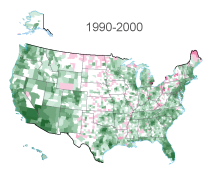

|
|
... examining a century of population change Harris County, Texas (Houston area) increased in population from 115,693 in 1910 to 4,092,459 in 2010. See how the county population changed, decade by decade, using the interactive table in this section. How have your counties of interest changed in population since 2000? during the past century? Find out ... key in a county name of interest using the interactive table shown in this section. Decade-to-decade population change by county has varied greatly in the last century in many parts of the United States. This section presents U.S. by county map views depicting change by decade based on the decennial census. Use the related interactive table in this section to view, query, rank and compare counties of interest. The interactive table shows the Census 2010 population and the population change by decade for each county. County Population Change, Houston TX Area  View created using CV XE GIS and related GIS project. Thematic pattern (color fill pattern) shows population change 2000-2010. Bar charts show population change by decade, 1930-2010. Click graphic for larger view and additional details. ProximityOne User Group members ( join now, no fee) may use the software and GIS project to create similar views for any decade. Zoom to an area of interest. Add name, codes, or data values as labels. Add other geography. County Population Change, 2000-2010  Click graphic for larger view and details. Visualizing County Population Change by Decade -- scroll section In the 1930s, 1940s, and 1950s, much of eastern Texas population declined (pink shaded counties). Those areas have seen strong population growth since then (green shaded counties).           County Population Change 1910-2010 Interactive Ranking Table Click ShowAll button to show all areas; Click column header to sort; click again to sort other direction. See related Ranking Tables Main Page. Contact ProximityOne for additional information. Notes Data in the table were developed by the Census Bureau. Values showing "below 500" were converted to the numeric value 499. The value 499 represents change values from -499 to 499. When a change value is in this range, the value 499 appears in the table. When 499 appears in the change value, all that can be determined from the table is that the true value is in the range -499 to 499. In general, it is possible to compute the population for any decennial census date by starting with the Census 2010 population and subtracting gains and adding losses, except for the 499 values which might be treated as zero (but will likely yield a factually inaccurate number). Example. Copy the Harris County, TX row to clipboard. Paste into cell A1 of an Excel spreadsheet. Set cell O2 to D2-SUM(E2:N2). The computed total population for Harris County, TX as of the 1910 Census is 115,693. 
Related Data • County Demographic Projections to 2020 with age breakout • County Demographic Projections to 2060 • County population 1790 to 1990 by decade (xls) -- requires User Group ID. • County Demographics; 2000 & 2010 Support Using these Resources Learn more about accessing and using ACS data integrated with other data; examine characteristics and patterns for your study areas and applications. Join us in a Decision-Making Information Web session. There is no fee for these one-hour Web sessions. Each informal session is focused on a specific topic. The open structure also provides for Q&A and discussion of application issues of interest to participants. Additional Information ProximityOne develops geographic-demographic-economic data and analytical tools and helps organizations knit together and use diverse data in a decision-making and analytical framework. We develop custom demographic/economic estimates and projections, develop geographic and geocoded address files, and assist with impact and geospatial analyses. Wide-ranging organizations use our tools (software, data, methodologies) to analyze their own data integrated with other data. Follow ProximityOne on Twitter at www.twitter.com/proximityone. Contact us (888-364-7656) with questions about data covered in this section or to discuss custom estimates, projections or analyses for your areas of interest. |
|
|